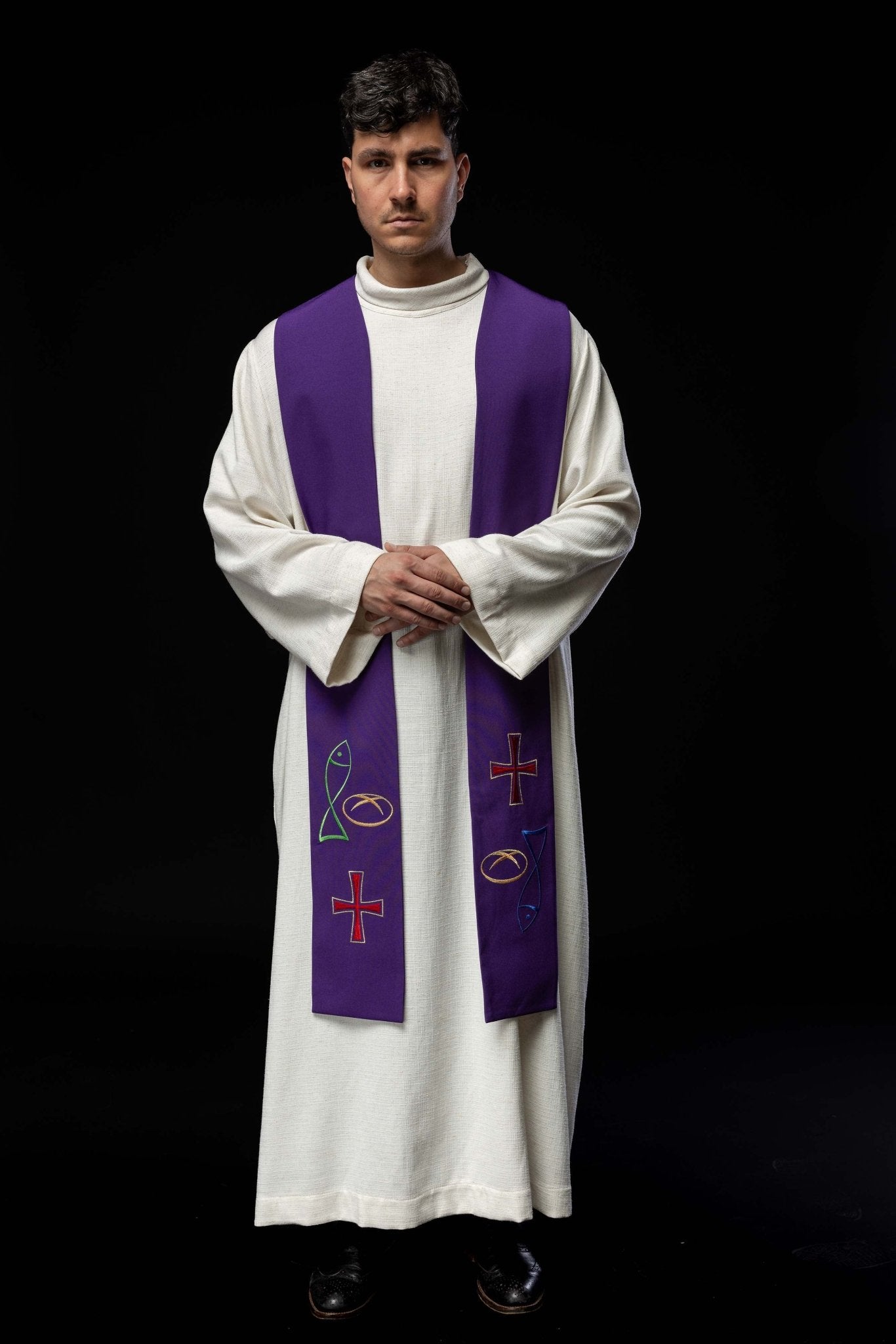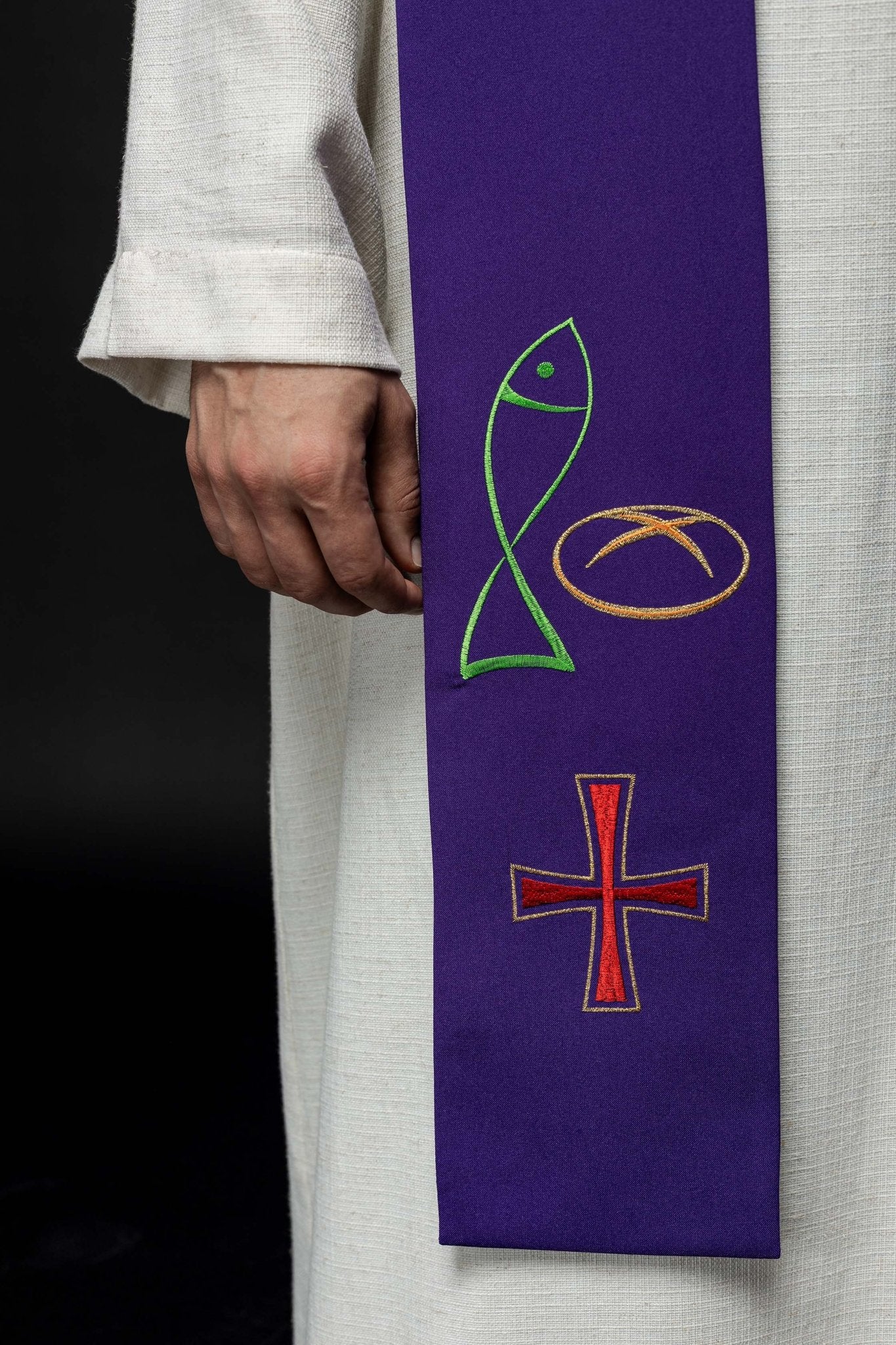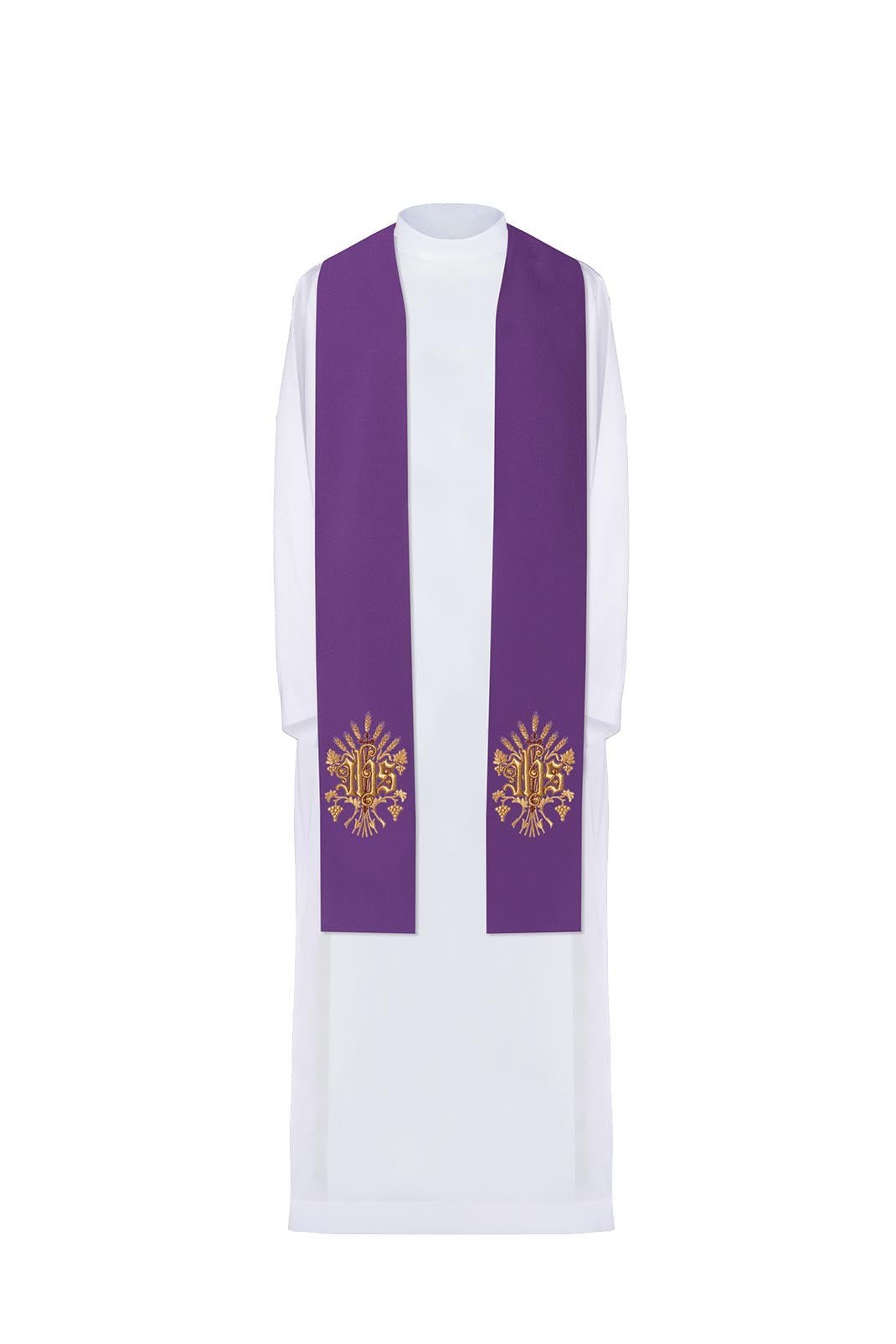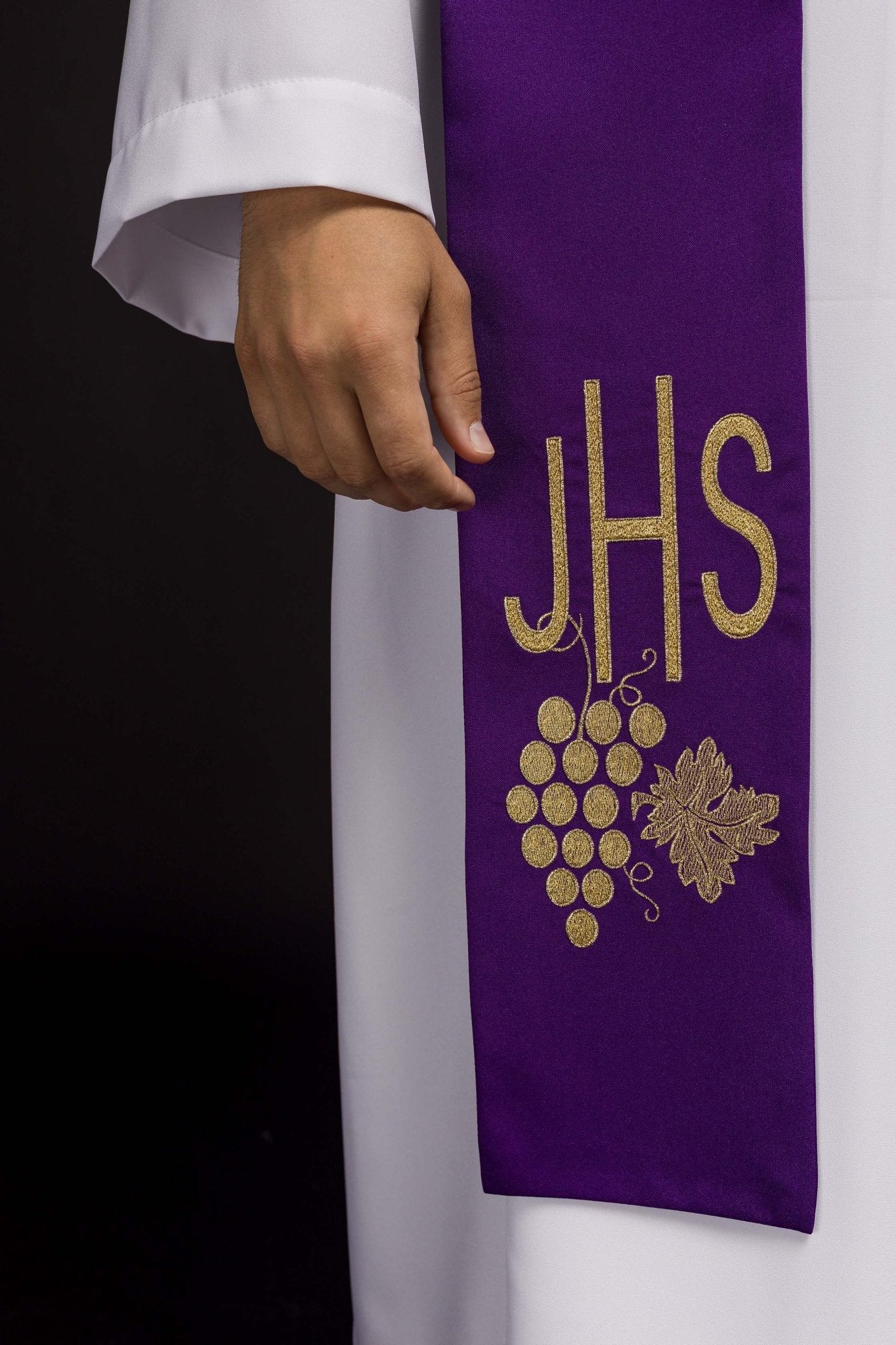Purple Stoles: A Symbol of Penance, Preparation, and Royalty
The Significance of Purple in Liturgical Vestments
Purple, a color often associated with royalty, penitence, and preparation, holds a significant place in the liturgical calendar. Purple stoles, in particular, are worn by clergy during specific seasons and occasions, each carrying its own unique meaning and symbolism. Understanding the significance of purple stoles can deepen your appreciation for the liturgical traditions and the spiritual messages they convey.
When are Purple Stoles Worn?
Purple stoles are primarily worn during two major liturgical seasons: Advent and Lent. These seasons are times of reflection, repentance, and preparation for the coming of Christ. Let's delve into the specific reasons why purple is chosen for each season:
Advent: A Time of Hopeful Anticipation
Advent is the season of preparation for the celebration of Christmas, the birth of Jesus Christ. Purple symbolizes the anticipation and longing for the coming of the Messiah. It also represents the penitential aspect of preparing our hearts to receive Christ anew. The purple stole reminds clergy and congregations alike to examine their lives, repent of their sins, and eagerly await the arrival of the Savior.
Lent: A Season of Repentance and Renewal
Lent is the season of preparation for Easter, the celebration of the resurrection of Jesus Christ. Purple takes on a more somber tone during Lent, representing the sorrow and penitence associated with Christ's suffering and death. The purple stole serves as a visual reminder of the need for repentance, fasting, and prayer as we journey with Christ towards the cross. It calls us to confront our own mortality, examine our relationship with God, and seek spiritual renewal.
Beyond Advent and Lent: Other Occasions for Purple Stoles
While purple stoles are most commonly associated with Advent and Lent, they can also be worn during other occasions that call for repentance, mourning, or solemnity. These may include:
Funerals and Memorial Services
Purple can be worn at funerals and memorial services to symbolize mourning, grief, and the hope of eternal life. It acknowledges the sorrow of loss while also pointing towards the promise of resurrection and the comforting presence of God.
Penitential Services
Services specifically focused on repentance and confession may also feature purple stoles. These services provide an opportunity for individuals and communities to acknowledge their sins, seek forgiveness, and experience God's grace.
Special Days of Prayer
Certain days of prayer or vigils may call for the use of purple stoles, particularly if the focus is on repentance, intercession, or seeking God's guidance during challenging times.
The Design and Materials of Purple Stoles
Purple stoles come in a variety of designs, materials, and embellishments. The specific style often reflects the traditions and preferences of the church or denomination. Here are some common features to consider:
Fabric
Purple stoles can be made from a wide range of fabrics, including:
-
Brocade: A rich, decorative fabric with raised patterns, often incorporating gold or silver threads.
-
Damask: A reversible fabric with a subtle, woven pattern, offering a touch of elegance.
-
Velvet: A soft, luxurious fabric with a plush pile, adding a sense of richness and dignity.
-
Linen: A natural, breathable fabric that is often used for simpler, more understated stoles.
-
Polyester: A durable, wrinkle-resistant fabric that is easy to care for and often more affordable.
Embroidery and Appliqués
Many purple stoles feature embroidery or appliqués, adding symbolic and decorative elements. Common motifs include:
-
Crosses: Representing the sacrifice of Jesus Christ and the Christian faith.
-
Crowns: Symbolizing the royalty of Christ and the hope of eternal life.
-
Thorns: Representing the suffering of Christ during his Passion.
-
Scriptural Symbols: Such as the Chi Rho (a symbol for Christ) or the Alpha and Omega (representing God as the beginning and the end).
Shape and Style
Purple stoles can vary in shape and style, depending on the liturgical tradition:
-
Roman Stole: A wider stole that hangs straight down from the neck, often with decorative ends.
-
Gothic Stole: A narrower stole that is often slightly tapered and may be worn crossed over the chest.
-
Deacon's Stole: Worn diagonally across the chest, symbolizing the deacon's role as a servant of the church.
Choosing the Right Purple Stole
Selecting the right purple stole involves considering several factors, including the liturgical season, the occasion, the church's traditions, and the personal preferences of the clergy member. Here are some tips to guide your decision:
Consider the Liturgical Season
For Advent, a lighter shade of purple or violet may be appropriate, symbolizing hope and anticipation. For Lent, a darker, more somber shade of purple is often preferred, reflecting the penitential nature of the season.
Reflect on the Occasion
For funerals or memorial services, a simple, understated purple stole may be more suitable. For special days of prayer, the design and embellishments can reflect the specific theme or focus of the service.
Respect Church Traditions
Different denominations and churches may have specific guidelines or preferences regarding the design and materials of liturgical vestments. It's important to be aware of these traditions and choose a purple stole that aligns with them.
Personal Preference
Ultimately, the choice of a purple stole is a personal one. Clergy members should select a stole that resonates with them and helps them to feel connected to the liturgical traditions and the spiritual messages they convey.
Caring for Your Purple Stole
Proper care and maintenance can help to ensure that your purple stole lasts for many years. Here are some general tips:
Follow the Manufacturer's Instructions
Always refer to the manufacturer's instructions for specific care recommendations. Different fabrics and embellishments may require different cleaning methods.
Hand Wash or Dry Clean
Many purple stoles are delicate and should be hand washed or dry cleaned to prevent damage. Avoid machine washing unless the manufacturer specifically recommends it.
Store Properly
When not in use, store your purple stole in a garment bag or a cool, dry place to protect it from dust, moths, and sunlight. Avoid hanging it for extended periods, as this can cause the fabric to stretch or wrinkle.
The Enduring Symbolism of Purple Stoles
Purple stoles serve as a powerful visual reminder of the importance of repentance, preparation, and hope in the Christian faith. By understanding the significance of this liturgical vestment, we can deepen our appreciation for the rich traditions of the church and the spiritual messages they convey. Whether worn during Advent, Lent, or other occasions, the purple stole invites us to reflect on our lives, seek God's forgiveness, and eagerly await the coming of Christ.
The History of Purple Stoles
The use of purple in liturgical vestments has a long and rich history, dating back to the early days of the Church. Understanding this history can provide a deeper appreciation for the symbolism and significance of purple stoles today.
Early Christian Symbolism
In the early Church, purple was often associated with royalty and authority, as it was a color worn by emperors and other high-ranking officials. However, purple also carried connotations of mourning and penitence, reflecting the suffering of Christ and the need for repentance.
Development of Liturgical Colors
Over time, the Church began to develop a more formalized system of liturgical colors, assigning specific colors to different seasons and occasions. Purple gradually became associated with Advent and Lent, seasons of preparation and penitence.
Medieval and Renaissance Traditions
During the Medieval and Renaissance periods, purple stoles became increasingly elaborate and ornate, often featuring intricate embroidery and precious gemstones. These stoles were seen as symbols of the Church's wealth and power, as well as expressions of devotion and reverence.
Reformation and Beyond
The Protestant Reformation brought about significant changes in liturgical practices, including the use of liturgical colors. Some Protestant denominations abandoned the use of purple stoles altogether, while others retained them but with a more simplified design.
Modern Usage
Today, purple stoles are widely used in both Catholic and Protestant churches, although the specific design and usage may vary depending on the denomination. They continue to serve as a powerful visual reminder of the importance of repentance, preparation, and hope in the Christian faith.
Variations in Purple Stole Designs
While purple stoles share a common color, there is a wide range of variations in design and embellishments. These variations often reflect the traditions and preferences of different churches and denominations.
Shades of Purple
Purple stoles can range in shade from light violet to deep plum. The specific shade chosen may depend on the liturgical season or the occasion. For example, a lighter shade of violet may be used during Advent, while a darker shade of purple may be used during Lent.
Embroidery and Appliqués
Purple stoles can be adorned with a variety of embroidery and appliqués, including crosses, crowns, thorns, and scriptural symbols. The specific motifs chosen may reflect the theme or focus of the liturgical season or the occasion.
Fabric and Texture
Purple stoles can be made from a variety of fabrics, including brocade, damask, velvet, linen, and polyester. The choice of fabric can affect the overall look and feel of the stole, as well as its durability and ease of care.
Shape and Style
Purple stoles can vary in shape and style, depending on the liturgical tradition. Roman stoles are wider and hang straight down from the neck, while Gothic stoles are narrower and may be worn crossed over the chest. Deacon's stoles are worn diagonally across the chest.
The Psychology of Purple
The color purple has a long and complex history, and its psychological associations can vary depending on cultural context. However, in Western cultures, purple is often associated with:
Royalty and Nobility
Purple has long been associated with royalty and nobility, as it was a rare and expensive dye to produce. In ancient times, only the wealthiest and most powerful individuals could afford to wear purple clothing.
Spirituality and Mystery
Purple is also associated with spirituality and mystery, as it is often seen as a color that connects the earthly and the divine. It is often used in religious settings to create a sense of reverence and awe.
Creativity and Imagination
Purple is also associated with creativity and imagination, as it is often seen as a color that stimulates the mind and encourages new ideas. It is often used in artistic and design settings to create a sense of inspiration and innovation.
Mourning and Penitence
In some cultures, purple is also associated with mourning and penitence, as it is seen as a color that represents sorrow and regret. This association is particularly strong during the season of Lent.
Purple Stoles in Different Denominations
The use of purple stoles varies among different Christian denominations. While the symbolism of repentance and preparation remains consistent, specific practices may differ.
Catholic Church
In the Catholic Church, purple is the primary color for Advent and Lent. Priests and deacons wear purple stoles during these seasons, as well as during penitential services and funerals.
Anglican Church
The Anglican Church follows a similar pattern to the Catholic Church, using purple for Advent and Lent. Some Anglican traditions may also use blue as an alternative color for Advent, symbolizing hope.
Lutheran Church
The Lutheran Church also uses purple for Advent and Lent. The specific shade of purple may vary depending on the congregation's preferences.
Methodist Church
The Methodist Church generally follows the same liturgical color scheme as the Catholic, Anglican, and Lutheran churches, using purple for Advent and Lent.
Other Protestant Denominations
Some other Protestant denominations may use purple less frequently, or may have alternative liturgical color schemes. However, the symbolism of repentance and preparation remains an important theme in most Christian traditions.
Purchasing Purple Stoles
When purchasing a purple stole, consider the following factors:
Quality of Materials
Choose a stole made from high-quality materials that will last for many years. Look for fabrics that are durable, wrinkle-resistant, and easy to care for.
Design and Embellishments
Select a design that is appropriate for the liturgical season and the occasion. Consider the symbolism of any embroidery or appliqués.
Comfort and Fit
Ensure that the stole is comfortable to wear and fits properly. Consider the length and width of the stole, as well as the neckline.
Price
Purple stoles can range in price from affordable to expensive. Set a budget and look for a stole that offers good value for the money.
Reputable Supplier
Purchase your purple stole from a reputable supplier that specializes in liturgical vestments. Look for a supplier with a good reputation for quality and customer service.
Conclusion: The Enduring Significance of Purple Stoles
Purple stoles are more than just pieces of fabric they are powerful symbols that connect us to the rich traditions of the Christian faith. By understanding the history, symbolism, and variations of purple stoles, we can deepen our appreciation for their significance and the spiritual messages they convey. Whether worn during Advent, Lent, or other occasions, the purple stole invites us to reflect on our lives, seek God's forgiveness, and eagerly await the coming of Christ.























































